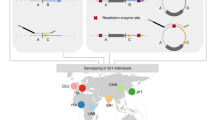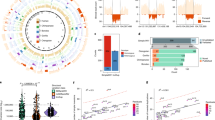Abstract
A refined physical map of chromosome 17q21.31 uncovered a 900-kb inversion polymorphism. Chromosomes with the inverted segment in different orientations represent two distinct lineages, H1 and H2, that have diverged for as much as 3 million years and show no evidence of having recombined. The H2 lineage is rare in Africans, almost absent in East Asians but found at a frequency of 20% in Europeans, in whom the haplotype structure is indicative of a history of positive selection. Here we show that the H2 lineage is undergoing positive selection in the Icelandic population, such that carrier females have more children and have higher recombination rates than noncarriers.
This is a preview of subscription content, access via your institution
Access options
Subscribe to this journal
Receive 12 print issues and online access
$209.00 per year
only $17.42 per issue
Buy this article
- Purchase on Springer Link
- Instant access to full article PDF
Prices may be subject to local taxes which are calculated during checkout






Similar content being viewed by others
References
Sebat, J. et al. Large-scale copy number polymorphism in the human genome. Science 305, 525–528 (2004).
Iafrate, A.J. et al. Detection of large-scale variation in the human genome. Nat. Genet. 36, 949–951 (2004).
Jin, H. et al. Structural evolution of the BRCA1 genomic region in primates. Genomics 84, 1071–1082 (2004).
Shaw, C.J. & Lupski, J.R. Implications of human genome architecture for rearrangement-based disorders: the genomic basis of disease. Hum. Mol. Genet. 13 Spec No 1 R57–R64 (2004).
Giglio, S. et al. Olfactory receptor-gene clusters, genomic-inversion polymorphisms, and common chromosome rearrangements. Am. J. Hum. Genet. 68, 874–883 (2001).
Baker, M. et al. Association of an extended haplotype in the tau gene with progressive supranuclear palsy. Hum. Mol. Genet. 8, 711–715 (1999).
Pittman, A.M. et al. The structure of the tau haplotype in controls and in progressive supranuclear palsy. Hum. Mol. Genet. 13, 1267–1274 (2004).
Skipper, L. et al. Linkage Disequilibrium and Association of MAPT H1 in Parkinson Disease. Am. J. Hum. Genet. 75, 669–677 (2004).
Oliveira, S.A. et al. Linkage disequilibrium and haplotype tagging polymorphisms in the Tau H1 haplotype. Neurogenetics 5, 147–155 (2004).
Farrer, M. et al. The tau H1 haplotype is associated with Parkinson's disease in the Norwegian population. Neurosci. Lett. 322, 83–86 (2002).
Conrad, C. et al. Molecular evolution and genetics of the Saitohin gene and tau haplotype in Alzheimer's disease and argyrophilic grain disease. J. Neurochem. 89, 179–188 (2004).
Kwok, J.B. et al. Tau haplotypes regulate transcription and are associated with Parkinson's disease. Ann. Neurol. 55, 329–334 (2004).
Chen, F.C. & Li, W.H. Genomic divergences between humans and other hominoids and the effective population size of the common ancestor of humans and chimpanzees. Am. J. Hum. Genet. 68, 444–456 (2001).
Excoffier, L. Human demographic history: refining the recent African origin model. Curr. Opin. Genet. Dev. 12, 675–682 (2002).
The International HapMap Consortium. The International HapMap Project. Nature 426, 789–796 (2003).
The International HapMap Consortium. Integrating ethics and science in the International HapMap Project. Nat. Rev. Genet. 5, 467–475 (2004).
Bamshad, M. & Wooding, S.P. Signatures of natural selection in the human genome. Nat. Rev. Genet. 4, 99–111 (2003).
Toomajian, C., Ajioka, R.S., Jorde, L.B., Kushner, J.P. & Kreitman, M. A method for detecting recent selection in the human genome from allele age estimates. Genetics 165, 287–297 (2003).
Osier, M.V. et al. ALFRED: An allele frequency database for anthropology. Am. J. Phys. Anthropol. 119, 77–83 (2002).
Evans, W. et al. The tau H2 haplotype is almost exclusively Caucasian in origin. Neurosci. Lett. 369, 183–185 (2004).
Kong, A. et al. Recombination rate and reproductive success in humans. Nat. Genet. 36, 1203–1206 (2004).
Kong, A. et al. A high-resolution recombination map of the human genome. Nat. Genet. 31, 241–247 (2002).
Broman, K.W., Murray, J.C., Sheffield, V.C., White, R.L. & Weber, J.L. Comprehensive human genetic maps: individual and sex-specific variation in recombination. Am. J. Hum. Genet. 63, 861–869 (1998).
Schaeffer, S.W. et al. Evolutionary genomics of inversions in Drosophila pseudoobscura: evidence for epistasis. Proc. Natl. Acad. Sci. USA 100, 8319–8324 (2003).
Carroll, S.B. Genetics and the making of Homo sapiens. Nature 422, 849–857 (2003).
Andolfatto, P., Depaulis, F. & Navarro, A. Inversion polymorphisms and nucleotide variability in Drosophila. Genet. Res. 77, 1–8 (2001).
Brown, P. et al. A new small-bodied hominin from the Late Pleistocene of Flores, Indonesia. Nature 431, 1055–1061 (2004).
Reed, D.L., Smith, V.S., Hammond, S.L., Rogers, A.R. & Clayton, D.H. Genetic analysis of lice supports direct contact between modern and archaic humans. PLoS Biol. 2, 340 (2004).
Lewin, R. & Foley, R.A. Principles of Human Evolution (Blackwell, Oxford, 2004).
Sabeti, P.C. et al. Detecting recent positive selection in the human genome from haplotype structure. Nature 419, 832–837 (2002).
Nachman, M.W. & Crowell, S.L. Contrasting evolutionary histories of two introns of the duchenne muscular dystrophy gene, Dmd, in humans. Genetics 155, 1855–1864 (2000).
Gilad, Y., Rosenberg, S., Przeworski, M., Lancet, D. & Skorecki, K. Evidence for positive selection and population structure at the human MAO-A gene. Proc. Natl. Acad. Sci. USA 99, 862–867 (2002).
Thompson, E.E. et al. CYP3A variation and the evolution of salt-sensitivity variants. Am. J. Hum. Genet. 75, 1059–1069 (2004).
Akey, J.M. et al. Population history and natural selection shape patterns of genetic variation in 132 genes. PLoS Biol. 2, e286 (2004).
Gulcher, J.R., Kristjansson, K., Gudbjartsson, H. & Stefansson, K. Protection of privacy by third-party encryption in genetic research in Iceland. Eur. J. Hum. Genet. 8, 739–742 (2000).
Kumar, S., Tamura, K. & Nei, M. MEGA3: Integrated software for Molecular Evolutionary Genetics Analysis and sequence alignment. Brief Bioinform. 5, 150–163 (2004).
Schwartz, S. et al. Human-mouse alignments with BLASTZ. Genome Res. 13, 103–107 (2003).
Gretarsdottir, S. et al. The gene encoding phosphodiesterase 4D confers risk of ischemic stroke. Nat. Genet. 35, 131–138 (2003).
Bandelt, H.J., Forster, P. & Rohl, A. Median-joining networks for inferring intraspecific phylogenies. Mol. Biol. Evol. 16, 37–48 (1999).
Slatkin, M. & Bertorelle, G. The use of intraallelic variability for testing neutrality and estimating population growth rate. Genetics 158, 865–874 (2001).
Laval, G. & Excoffier, L. SIMCOAL 2.0: a program to simulate genomic diversity over large recombining regions in a subdivided population with a complex history. Bioinformatics 20, 2485–2487 (2004).
Navarro, A., Barbadilla, A. & Ruiz, A. Effect of inversion polymorphism on the neutral nucleotide variability of linked chromosomal regions in Drosophila. Genetics 155, 685–698 (2000).
Dempster, A., Laird, N. & Rubin, D. Maximum likelihood from incomplete data via the EM algorithm. J. R. Stat. Soc. B 39, 1–38 (1977).
Spielman, R.S., McGinnis, R.E. & Ewens, W.J. Transmission test for linkage disequilibrium: the insulin gene region and insulin-dependent diabetes mellitus (IDDM). Am. J. Hum. Genet. 52, 506–516 (1993).
Conrad, C. et al. Genetic evidence for the involvement of tau in progressive supranuclear palsy. Ann. Neurol. 41, 277–281 (1997).
Acknowledgements
We thank D. Reich, N. Patterson and D. Donnelly for constructive comments regarding this work.
Author information
Authors and Affiliations
Corresponding authors
Ethics declarations
Competing interests
H. Stefansson, A. Helgason, G. Thorleifsson, V. Steinthorsdottir, G. Masson, A. Baker, A. Jonasdottir, A. Ingason, V. G. Gudnadottir, N. Desnica, A. Hicks, A. Gylfason, D. F. Gudbjartsson, G. M. Jonsdottir, J. Sainz, K. Agnarsson, B. Birgisdottir, S. Ghosh, A. Olafsdottir, J.-B. Cazier, K. Kristjansson, M. L. Frigge, T. E. Thorgeirsson, J. R. Gulcher, A. Kong & K. Stefansson own stock or stock options in deCODE Genetics.
Supplementary information
Supplementary Fig. 1
Genotype analysis on homozygous samples sharing (identical-by-descent) over the 17q21.31 locus. (PDF 597 kb)
Supplementary Fig. 2
The relative copy number for H1D1 and H1D3 variants compared to H2 variants estimated by gene dose analysis at three loci. (PDF 97 kb)
Supplementary Fig. 3
Five chromosomal variants with considerable variation in size at the inverted locus on 17q21.31. (PDF 87 kb)
Supplementary Fig. 4
Positive correlation is found between copy numbers of the 5′ end of the NSF gene per sample. (PDF 62 kb)
Supplementary Fig. 5
A sliding window analysis of sequence divergence in 5 kb sequence segments inside the inverted region of a 77 kb fragment that spans much of intron 1 and 2 from the MAPT gene from 44.444005-44.520949 Mb in the H1 orientation in Build 34. (PDF 203 kb)
Supplementary Fig. 6
LD between SNP markers spanning the inversion at 17q21.31. (PDF 241 kb)
Supplementary Fig. 7
The estimate frequency of H2 for females and males who have 0, 1, 2, 3, 4 and 5 or more children. (PDF 261 kb)
Supplementary Table 1
Available sequences and contigs from the RP11 library mapping to 17q21.31. (PDF 160 kb)
Supplementary Table 2
Test for the impact of selection of H2 chromosomes in the Utah sample using the mutational diversity of five microsatellites. (PDF 319 kb)
Supplementary Table 3
The distribution of the number of children for 82,992 Icelandic males and for 79,811 Icelandic females born between 1925 and 1965. (PDF 251 kb)
Supplementary Table 4
Results from multiple regression analyses for a cohort of 16959 females and 12178 males born between 1925 and 1965. (PDF 230 kb)
Supplementary Table 6
Difference in mutation rate for microsatellites on H1 and H2 backgrounds. (PDF 189 kb)
Rights and permissions
About this article
Cite this article
Stefansson, H., Helgason, A., Thorleifsson, G. et al. A common inversion under selection in Europeans. Nat Genet 37, 129–137 (2005). https://doi.org/10.1038/ng1508
Received:
Accepted:
Published:
Issue Date:
DOI: https://doi.org/10.1038/ng1508
This article is cited by
-
A new blood DNA methylation signature for Koolen-de Vries syndrome: Classification of missense KANSL1 variants and comparison to fibroblast cells
European Journal of Human Genetics (2024)
-
High level of complexity and global diversity of the 3q29 locus revealed by optical mapping and long-read sequencing
Genome Medicine (2023)
-
Neolithic expansion and the 17q21.31 inversion in Iberia: an evolutionary approach to H2 haplotype distribution in the Near East and Europe
Molecular Genetics and Genomics (2023)
-
Pathomechanisms of cognitive impairment in progressive supranuclear palsy
Journal of Neural Transmission (2023)
-
The early-life exposome modulates the effect of polymorphic inversions on DNA methylation
Communications Biology (2022)



